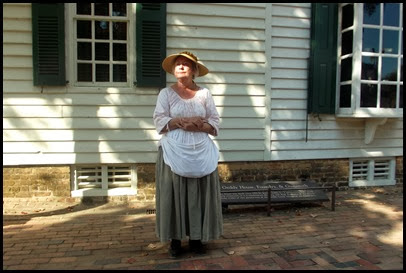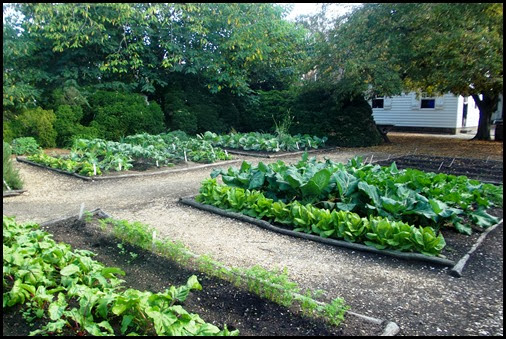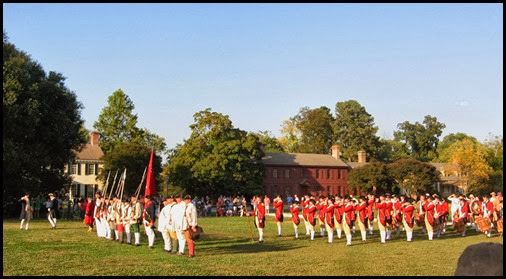Friday October 4, 2013
Colonial Williamsburg
After doing my civic duty as a judge, we walk up to the corner of Duke of Gloucester Street to the Geddy House.
If you missed the post on our activities earlier this day including the trial, you can read it here. Mr. James Geddy is a merchant, a well to do merchant but still in a class lower than the gentry of which Mr. Wythe is a member. While Americans are in the beginnings of the idea of freedom from crown domination, they are still a very classed society with the royal governor at the top, and the gentry, meaning large land owners, the “ladies and gentlemen”, next in line. They are followed by the “middling sort” a new class made up in this country of tradesmen-blacksmiths, cobblers, milliners, printers and silversmiths. Members of the “middling class” also worked as “professionals” – lawyers, doctors and merchants who owned stores. Mr. Geddy is a silversmith. His property contains his home and his foundry, gunsmith and silversmith businesses.
As we are ushered into Mr. Geddy’s retail store which is on one side of his home, this lady is patiently waiting outside the house for Mr. Geddy’s return.
In Mr. Geddy’s shop there are some beautiful pieces of silver - flatware, belt buckles, trays, candlesticks, pitchers and bowls to name a few.
Mr. Geddy’s daughter Anne is playing the spinet in the dining room and we are invited to come in and listen. What a beautiful instrument, both its cabinet and the sound of the music. She’s an excellent musician.
Miss Geddy tells us about the instrument which is new to the colonies and apologizes for her father’s continued absence She encourages us to go out into their extensive vegetable garden. It appears that every house in town has a large kitchen garden. I love to see these gardens. They remind me so much of the large raised vegetable beds we grew for years. Looks delicious and so fresh. I am missing the fresh produce on the road.
We walk back to the foundry and gunsmith shop but see there are many people in line to pick up or place orders so we resolve to return another day.
Across the street we notice the shoemaker’s shop is open.
He is certainly well prepared for the coolness of fall with his split firewood supply.
Mr. George Wilson is hard at work and has quite an array of shoes hanging all around his small shop.
He explains that he is a trained shoe MAKER, not a cobbler who is a shoe repairman with 5 years less experience than he.
He points out the foot forms against the wall and tell us that his shoes are made for either foot but within a short period of time the wearer’s feet will shape them to fit for only right or left.
Mr. Wilson also explains that he is a maker of boots and shoes for men. He makes the shoes and others supply the buckles. Others like Mr. Geddy. Gentle women’s shoes are made elsewhere often of cloth, silk or brocade, to match their gowns.
Neither of us is in the market for shoes today so we walk on down the street passing other shops and taverns.
We are passing the armory when we hear the drums and then the fife.
People stop their talking and hurry along toward market square where the local militia are gathering to march in review and be addressed by their general. We hurry along too not wanting to miss the show.
This was one of Carrie’s favorite parts of a trip to Colonial Williamsburg and I wish I could find the picture we have of her in costume skipping down the street after the fife and drum.
They look very impressive as they march along and while standing and waiting for the troops.
And then the little militia arrives. Oh my, there are far more drummers and fifers than militia. I wonder if we can win the war with so few as these.
When the general arrives, we understand.
The French have come to help us. Thank goodness!! It is the Marquis de Lafayette who rides in and delivers a fiery address which has everyone cheering.
As the general of the branch of the army at Williamsburg, he has important business and charges off the field leaving the troops to their practice maneuvers. War is on the way.
There is a lot of talk among the crowd and some of the ladies leave before the loud maneuvers begin. Dainty ears?? :-)
The troops practice with their muskets
with their bayonets
and with the canon.
After the maneuvers, they march in an orderly fashion off the field.
This is our signal. It’s been a long and full day here in the 18th Century.
We head toward the car and are surprised to find that a 21st Century party is going on at the end of Duke of Gloucester Street in Merchant's Square. There is a stage at one end and folks have set their chairs up waiting for the music to begin.
Others are circling their wagons. For them it seems not to be about the music.
Apparently this is the 85th birthday of Merchant’s Square and they are having a birthday party complete with discounted food from local restaurants. The sun is getting lower and lower in the sky. After a long day of walking, it looks like dinner to us. So we get in the line which is not too bad yet.
We make it into the tent, select our food and finally find a bench where we can sit and eat it.
As we leave, I find Mr. Jefferson still hard at work. He is just writing and writing. I give him a good luck kiss and hope he makes his deadline and is not still here tomorrow when we come back again to visit Colonial Williamsburg.






































Absolutely love Fife & Drum processions! You guys lucked out getting in on the dinner & music :)
ReplyDeleteGreat tour! We really enjoy Williamsburg. When we lived in the area, we had annual passes:)
ReplyDeleteFife and drum!!! Love it :) The costumes are great all around. So neat that they keep the story going day in and day out. Living history at its best! The Jefferson kiss in that hat! Priceless ;)
ReplyDeleteI sure hope David didn't catch you kissing Mr. J! :cO
ReplyDeleteWell, I didn't see the shoemaker either! I guess the hunky guy chopping wood distracted me… can't remember.
ReplyDeleteWhat a great place this is… I wish I had paid more attention to more things… I loved walking all over that place… maybe I was there in off season? It was 2007 and I didn't blog then… but everything you have shown except for the inside of the places and the reenactment … I remember … I would have LOVED to have seen the drummers and fifers … ratst
Love the dresses but glad we aren't that encumbered in the TWENTY FIRST century… LOL ~ you and Gypsy….
You kissed Mr. Jefferson … ha! whatta kid… great tour and pictures … as always
I love this idea of just walking into history, and then dinner too as a bonus.
ReplyDeleteInteresting, but I'm sure glad I wasn't around back then. I would probably have been hung in the public square!
ReplyDeleteOOH Gypsy they didn't hang women folk back then, they just sent you upstairs and no one heard form you again...Don't know which is best...
DeletePs
Great post as always Sherry and the picture you don't even have to enlarge.
What an adorable picture of you and Mr. Jefferson.
ReplyDeleteThat's the way to learn history...just walk right into it;o)) That was a very long day but you sure cover a lot of territory.
ReplyDeleteI did catch her Paul - that's how she got the picture. It's okay with me if she is attracted to our home town hero - who has been dead for over two centuries. He was her kind of guy - a man of letters, books and creation. I love all the period clothing. Wish I had spoken to more of the reenactors on the street to see where they lived and ask how they felt about their class society & the talk of a revolution. I am sure they each have a good story.
ReplyDeleteLooks like you are having quite a sightseeing extravaganza! Your commentary and photos of the re-enactments are witty and enlightening...Thanks for the great tour.
ReplyDeleteLove every minute.
ReplyDeleteAnd a party to boot! Good day!
ReplyDelete